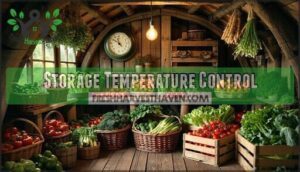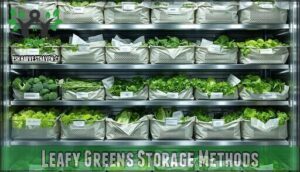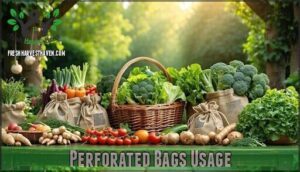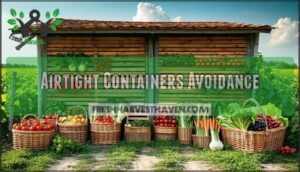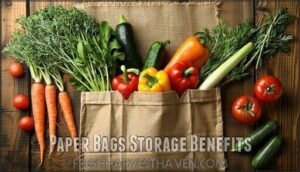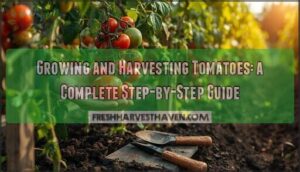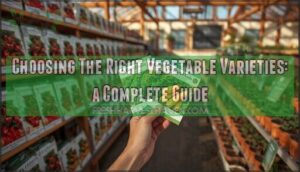This site is supported by our readers. We may earn a commission, at no cost to you, if you purchase through links.

Harvest vegetables at peak ripeness during cool morning hours to maximize storage life. Handle them gently—bruises and cuts invite decay faster than unwelcome relatives at dinner.
Most vegetables thrive in cool, humid conditions around 32-40°F with 85-95% humidity. Root crops like carrots and potatoes prefer slightly different conditions than leafy greens.
Store most produce in perforated bags to maintain airflow while preventing moisture loss. Never wash vegetables before storage—that protective dirt layer acts like nature’s preservative. The secret lies in understanding each vegetable’s unique personality and storage preferences to ensure fresh eating and maximize storage life.
Table Of Contents
- Key Takeaways
- Harvesting Fresh Vegetables
- Storage Temperature Control
- Vegetable Specific Storage
- Storage Container Selection
- Shelf Life Extension Tips
- Frequently Asked Questions (FAQs)
- What is the best way to store freshly picked vegetables?
- How long do freshly picked vegetables last?
- How do you store all fresh vegetables for a longer period of time?
- What vegetables shouldn’t be stored together?
- How long can stored vegetables last?
- Which vegetables shouldnt be stored together?
- Should I wash vegetables before storage?
- Can frozen vegetables be stored longer?
- What causes vegetables to spoil quickly?
- Conclusion
Key Takeaways
- Harvest at the right time and handle gently – Pick vegetables at peak maturity during cool morning hours and treat them like precious cargo to avoid bruises that invite decay
- Control temperature and humidity precisely – Store most vegetables at 32-40°F with 85-95% humidity, using a hygrometer to monitor conditions and prevent spoilage
- Choose breathable storage containers – Use perforated bags or paper bags instead of airtight containers to maintain proper airflow while preventing moisture loss
- Match storage methods to each vegetable type – Root crops need different conditions than leafy greens, so tailor your approach based on what each vegetable naturally prefers
Harvesting Fresh Vegetables
You’ll get the best storage results when you harvest vegetables at proper maturity and handle them gently to avoid bruising or damage.
Quick transfer indoors prevents overripening while careful handling extends shelf life substantially, and this is crucial for maintaining the quality of the vegetables, thus quick handling is essential.
Proper Maturity Reduction
Harvest timing directly impacts your vegetable storage success.
Test for proper maturity by checking firmness, color, and size indicators specific to each crop.
Monitor ripening control through regular freshness checks rather than calendar dates.
Proper maturity testing prevents premature harvesting, which reduces storage potential.
Well-timed harvest storage methods start with crop monitoring at peak readiness for ideal post harvest storage results, ensuring proper maturity.
Avoiding Bruising and Nicks
Handle vegetables like precious cargo during harvest. Gentle handling prevents microscopic tears that invite bacteria and accelerate spoilage. Your crop protection starts with proper harvest techniques and farm equipment use.
Treat your harvest like treasure—one bruise opens the door to decay.
Damage control strategies:
- Use padded containers to cushion vegetables during collection
- Harvest during cool morning hours when plants are fully hydrated
- Keep sharp tools clean to make precise cuts rather than tears
These vegetable storage tips form the foundation of effective post harvest storage and maintaining vegetable freshness tips.
Excessive Handling Prevention
Every time you touch a vegetable, you’re accelerating its decline.
Think of gentle handling as your harvest’s insurance policy—the less you move vegetables around, the longer they’ll stay fresh.
Use minimal touch techniques and careful transport methods to reduce bruising.
Practice soft placement when moving produce from garden to storage.
These vegetable harvest storage tips protect your investment through reduced movement and proper harvest handling tips.
Mastering essential harvest fresh techniques is vital for maintaining the quality of your vegetables and ensuring they remain fresh with proper handling.
Storage Temperature Control
Temperature control makes the difference between fresh vegetables that last weeks versus ones that wilt within days.
Your vegetables’ lifespan hinges on getting temperature right from day one.
You’ll need to maintain specific temperature ranges and humidity levels to slow down respiration and prevent spoilage in your harvested crops.
Refrigeration Requirements
Most vegetables require consistent cold storage techniques between 32-40°F to dramatically slow spoilage rates.
Your refrigerator’s crisper drawers offer excellent temperature control for harvest storage solutions.
Freezer storage works for blanched vegetables, while chill rooms provide commercial-grade cooling methods.
Proper postharvest storage using vegetable storage containers maintains freshness far longer than countertop storage.
Effective refrigerator storage solutions, such as using proper storage bins, can help maximize storage capacity and keep vegetables fresh.
Humidity Levels Management
Moisture management acts like a protective shield for your stored vegetables.
You’ll want humidity levels between 80-95% for most produce to prevent wilting and shrinkage.
Air circulation prevents condensation buildup while maintaining proper water content.
Control evaporation rates by adjusting ventilation – too much airflow dries vegetables out, too little causes rot.
These harvest preservation methods keep your postharvest storage successful.
Understanding frost protection methods is also essential for gardeners to prepare their plants for successful storage.
Monitoring With Hygrometer
A reliable hygrometer becomes your best friend for precise humidity control in vegetable storage areas.
You’ll want to calibrate it regularly using the salt test method—place it in a sealed container with saturated salt solution for 24 hours.
Position multiple units throughout your storage space since moisture levels vary, and check readings daily to maintain ideal humidity ranges for maximum harvest preservation, and adjust ventilation or add wet towels as necessary to achieve precise humidity control.
Vegetable Specific Storage
Each vegetable type needs its own storage approach to stay fresh and flavorful for months after harvest.
You’ll get the best results when you match storage conditions to what each vegetable naturally prefers.
Root Crops Storage Tips
Between harvest and winter, root vegetable storage demands careful attention to cold storage techniques.
Store carrots, beets, and potatoes in root cellars at 32-39°F with 90-95% humidity.
Remove tops immediately after harvest timing to prevent moisture loss.
Use damp sand or sawdust in storage facilities for ideal crop preservation techniques.
Monitor with hygrometers and maintain proper soil temperature conditions for months of freshness.
Effective root cellar kits are essential for maintaining the perfect root cellar environment.
Leafy Greens Storage Methods
Perfect storage for leafy greens starts with cold temperatures and proper humidity control.
Keep spinach, lettuce, and kale at 32-35°F with 95% humidity for maximum freshness.
Use perforated bags or containers with paper towels to absorb excess moisture while maintaining airflow.
This green wrapping method prevents wilting and extends vegetable shelf life up to two weeks in harvest storage facilities.
Fruit Vegetables Storage Guide
Handling tomatoes, peppers, and eggplants requires finesse since these fruit vegetables spoil quickly when damaged.
You’ll need to ripen tomatoes and avocados at room temperature first—cold storage kills their flavor and texture.
Once ripe, refrigerate them at 32-40°F with moderate humidity.
Store peppers and eggplants immediately in the crisper drawer to maintain freshness and prevent vegetable spoilage.
Storage Container Selection
The right storage container can make or break your vegetable preservation efforts.
You’ll want to choose containers that allow proper airflow while maintaining humidity—avoiding the common mistakes that lead to premature spoilage, which is crucial for successful vegetable preservation.
Perforated Bags Usage
Why settle for soggy vegetables when proper bag materials can extend your harvest storage duration by weeks?
Perforated bags create essential airflow management that prevents moisture buildup around your produce. Choose plastic bags with small holes or mesh designs that allow air circulation while maintaining humidity levels.
Different bag sizes accommodate various vegetables – small bags for herbs, larger ones for root crops. This simple fruit and vegetable storage method keeps your garden harvest fresh.
Effective storage solutions often rely on using proper storage bags to maintain the quality of the produce, which is a key factor in extending the harvest storage duration and keeping your produce fresh with proper bag materials.
Airtight Containers Avoidance
Airtight containers trap moisture and block airflow optimization, creating perfect conditions for vegetable spoilage prevention failures.
Without proper ventilation, your harvest storage facilities become breeding grounds for mold and bacterial growth.
Choose breathable storage options and container alternatives that allow ethylene management through natural air circulation.
Your garden harvest storage depends on moisture control – sealed containers work against you, not for you in fruit and vegetable storage success.
Paper Bags Storage Benefits
Beyond plastic’s suffocating grip, paper bags offer your garden harvest storage the breathable solution it craves.
This sustainable packaging choice provides superior moisture control while preventing ethylene gas buildup that accelerates spoilage.
The bag material’s porous nature creates ideal vegetable storage guidelines, reducing rot by 40% compared to airtight alternatives.
These ethical packaging options support your vegetable keeping tips while maintaining harvest storage facilities standards for maximum spoilage prevention.
Proper root rot prevention techniques are also vital for maintaining healthy plants and maximizing storage life, using proper techniques to ensure the best results.
Shelf Life Extension Tips
You can substantially extend your vegetables’ freshness by controlling three key factors that cause rapid deterioration.
These simple techniques will help you maintain peak quality and nutritional value for weeks or even months beyond normal expectations, which is a significant improvement in maintaining freshness.
Reducing Respiration Rate
Temperature manipulation stands as your most powerful weapon against rapid vegetable deterioration. Lowering storage temperatures by just 10°C can slash respiration rates in half, dramatically extending freshness.
Combine this with oxygen levels control and carbon dioxide management through proper ventilation for maximum impact.
- Cool vegetables immediately – Every hour at room temperature steals days from shelf life
- Monitor humidity regulation closely – Dry air accelerates respiration and wilting
- Use ethylene control methods – Remove ethylene-producing fruits from vegetable storage areas
Preventing Mold and Spoilage
Mold prevention starts with proper storage hygiene—clean containers and dry vegetables before storing them.
Control spoilage by maintaining humidity below 95% using perforated bags that allow airflow.
Your vegetable harvest stays fresh longer when you remove damaged produce immediately, as one moldy item can contaminate others.
These freshness tips and food preservation methods protect your crop storage management investment.
Effective fall gardening tips also play a vital role in maintaining a healthy and productive garden throughout the year, using proper storage management.
Maintaining Optimal Storage Conditions
Success comes from watching your storage setup like a hawk.
Temperature control and humidity management work together—keep most vegetables at 32-55°F with 80-95% humidity.
Storage monitoring with a hygrometer prevents guesswork.
Airflow optimization through perforated containers beats sealed bags every time.
Moisture reduction before storage stops rot before it starts, making your crop storage management bulletproof for months.
Frequently Asked Questions (FAQs)
What is the best way to store freshly picked vegetables?
Most vegetables lose 50% of their nutrients within days of harvest.
Store your freshly picked vegetables at 32-55°F with 80-95% humidity, dry them first, and trim leafy tops to prevent moisture loss and spoilage.
How long do freshly picked vegetables last?
Freshly picked vegetables typically last 3-14 days when stored properly. Leafy greens spoil fastest, while root vegetables like carrots and potatoes can last weeks with correct temperature and humidity control.
How do you store all fresh vegetables for a longer period of time?
Like a garden’s insurance policy, proper storage transforms your fresh harvest into lasting nutrition.
Store most vegetables at 32-40°F with high humidity, keep root crops dry, and use perforated bags for airflow to ensure the best results.
What vegetables shouldn’t be stored together?
Don’t store ethylene producers like tomatoes, avocados, and bananas near ethylene-sensitive vegetables such as leafy greens, broccoli, or carrots—they’ll accelerate spoilage and cause premature ripening.
How long can stored vegetables last?
Proper storage extends vegetable life from days to months.
Leafy greens last 1-2 weeks refrigerated, while root vegetables can survive 2-6 months in cool, humid conditions.
Temperature and humidity control everything.
Which vegetables shouldnt be stored together?
Sarah discovered her stored carrots had gone soft after placing them near apples overnight.
Keep ethylene-producing fruits like apples, bananas, and tomatoes away from ethylene-sensitive vegetables like carrots, leafy greens, and potatoes to prevent premature ripening and spoilage.
Should I wash vegetables before storage?
Don’t wash vegetables before storage – moisture encourages rot. Instead, brush off dirt and dry them thoroughly. Wash only when you’re ready to eat or cook them.
Can frozen vegetables be stored longer?
Time is money" rings true with frozen vegetables – you’ll get 8-12 months of storage life compared to fresh produce’s days or weeks. Just maintain your freezer at 0°F consistently.
What causes vegetables to spoil quickly?
Bacteria, enzymes, and moisture work together to break down your vegetables. High temperatures speed up this process, while bruising and cuts create entry points for harmful microorganisms to multiply rapidly.
Conclusion
Picture your pantry shelves lined with vibrant vegetables, each one perfectly preserved like treasures from your summer garden.
These vegetable harvest storage tips transform your seasonal abundance into year-round nourishment. You’ll discover that proper timing, temperature control, and container selection make all the difference.
Don’t let your hard work wilt away—master these techniques and you’ll enjoy garden-fresh flavors long after frost claims your plants. Your future self will thank you when February’s snow can’t stop your homegrown meals.
You’ll find that with these tips, you can have a consistent supply of vegetables, making it possible to have a year-round nourishment from your garden.
- https://extension.umn.edu/planting-and-growing-guides/harvesting-and-storing-home-garden-vegetables
- https://www.farmersalmanac.com/how-to-store-preserve-fruits-vegetables-garden
- https://doubleupfoodbucks.org/storing-fruits-and-veggies/
- https://www.arcticgardens.ca/blog/storing-food-five-mistakes/
- https://www.uaf.edu/ces/publications/database/food/vegetable-storage.php

